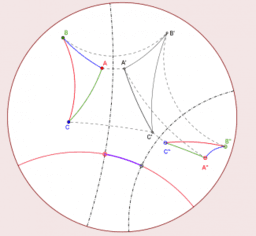Outline
A dynamic visualization of the hyperbolic geometry
“I have created a new, different world from nothing...” (János Bolyai)
Most of the primary and secondary school curriculum is based on Euclidean geometry. Our students are somewhat familiar with the life and works of János Bolyai’s, but his geometry, what is more, non-Euclidean geometries in general are completely unknown even for most secondary or university students.
Since it is impossible to study the topic precisely in an axiomatic way, teachers do not even exploit any opportunities for abstraction. In fact, if we can make non-Euclidean geometry visual, we can even enlighten the basic concepts of the “well-known” Euclidean geometry, including some simpler statements of it. We shall see that the well-known Euclidean geometry and Bolyai’s geometry, being visualized here, have common roots: all concepts before defining the axiom of parallels are valid in both geometries. In this way we can use the model presented here to provide a new approach to teach elementary geometry in secondary school as well. This GeoGebra Book uses only the basics from secondary school in order to define the main concepts of hyperbolic geometry.
We do not want to explain general knowledge on non-Euclidean geometries. Instead, a visual picture book is presented to invite the reader to learn more on the topic. Let us see then now, how Bolyai’s “new, different world” looks like!
Note: This book is the English translation of a Hungarian GeoGebra book on the same topic. The translation is an on-going work, so please expect several missing translations. However, all applets are already translated. In case the English text is missing, you may be interested in the original Hungarian text and try to translate it automatically in English, e.g. with Google Translator.

Table of Contents
01 Building up a geometry system with axioms
02 Models in geometry
03 Absolute geometry—hyperbolic geometry
04 Triangles
05 Problems (Congruence)
- 0501 Challenges
- 0502 Circle given with its center and radius
- 0503 Circle given with its diameter
- 0504 Measuring two segments
- 0505 Relationship among the sides of a triangle
- 0506 Point reflection
- 0507 Rotation
- 0508 Integers on the number line
- 0509 Translation parallel to a line by a multiple of the unit
- 0510 Translation parallel to a line by a given segment
- 0511 Concatenation of two reflections
06 Measuring segments and angles
07 Problems (Measuring)
- 0701 Challenges
- 0702 Defect of a triangle
- 0703 Copying angles
- 0704 Isosceles triangles
- 0705 Defining a number line with a function
- 0706 Relationship between sides and angles in a triangle
- 0707 Is Thales' circle theorem valid in hyperbolic geometry?
- 0708 Regular polygons
- 0709 Constructing ultraparallel lines
- 0710 Angle and distance of parallelism
08 Trigonometry
09 Tesselations
10 Pencils and cycles
11 Advanced problems
- 1101 Problems and constructions without tools of measurement
- 1102 Constructing tangents to a circle through an external point
- 1103 Cyclic quadrilaterals
- 1104 Parallelogram
- 1105 Midpoints of a triangle
- 1106 Triangles with equal areas
- 1107 A contest problem
- 1108 A lemma
- 1109 Circles that are tangent to each other and to a line
- 1110 Three circles
- 1111 Constructing lines that are perpendicular to a given line and tangent to a given circle
- 1112 Common tangents of two circles